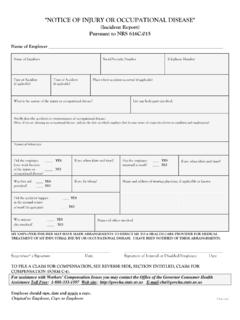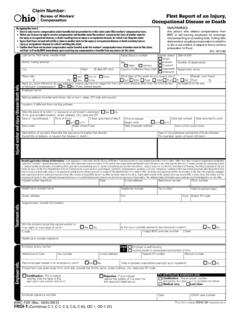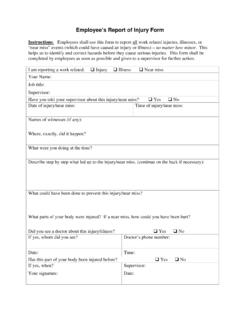Transcription of InjuryandIllness PreventionPrograms
1 injury and IllnessPrevention ProgramsWhite PaperJanuary Department of SummaryAninjury and illness prevention program,1is a proactive process to help employersfind and fix workplace hazards beforeworkers are hurt. We know theseprograms can be effective at reducinginjuries, illnesses, and fatalities. Manyworkplaces have already adopted suchapproaches, for example as part ofOSHA s cooperative programs. Not onlydo these employers experience dramaticdecreases in workplace injuries, but theyoften report a transformed workplaceculture that can lead to higherproductivity and quality, reduced turnover, reduced costs, and greater employee states and many nations around the world already require or encourage employers toimplement such programs. The key elements common to all of these programs are managementleadership, worker participation, hazard identification and assessment, hazard prevention andcontrol, education and training, and program evaluation and on the positive experience of employers with existing programs, OSHA believes thatinjury and illness prevention programs provide the foundation for breakthrough changes in theway employers identify and control hazards, leading to a significantly improved workplacehealth and safety environment.
2 Adoption of an injury and illness prevention program will resultin workers suffering fewer injuries, illnesses and fatalities. In addition, employers will improvetheir compliance with existing regulations, and will experience many of the financial benefits ofa safer and healthier workplace cited in published studies and reports by individual companies,including significant reductions in workers compensation occupational safety and health community uses various names to describe systematic approaches to reducing injuries andillnesses in the workplace. Consensus and international standards use the term Occupational Health and Safety ManagementSystems; OSHA currently uses the term injury and Illness Prevention Programs and others use Safety and Health Programs todescribe these types of systems.
3 Regardless of the title, they all systematically address workplace safety and health hazards on anongoing basis to reduce the extent and severity of work-related injuries and S H A I N J U RY A N D I L L N E S S P R E V E N T I O N P R O G R A M S W H I T E P A P E R1 BackgroundIn the four decades since theOccupational Safety and Health Act(OSH Act) was signed into law,workplace deaths and reported occupational injuries have dropped by more than 60 percent. Yetthe nation s workers continue to face an unacceptable number of work-related deaths, injuriesand illnesses, most of them preventable: Every day, more than 12 workers die on the job over 4,500 a year. Every year, more than million workers suffer a serious job-related injury or enhanced focus on prevention is needed to bring these numbers down.
4 To accomplish this, aneffective, flexible, commonsense tool is available that can dramatically reduce the number andseverity of workplace injuries and illnesses: the injury and illness prevention program. This toolhelps employers find hazards and fix thembeforeinjuries, illnesses or deaths occur. It helpsemployers meet their obligation under the OSH Act to furnish to each of his employeesemployment and a place of employment which are free from recognized hazards that are causingor are likely to cause death or serious physical harm to his employees. It also helps employersavoid the significant costs associated with injuries and illnesses in the and illness prevention programs are not new, nor are they untested. Most large companieswhose safety and health achievements have been recognized through government or industryawards cite their use of injury and illness prevention programs as their key to success.
5 Convincedof the value, effectiveness, and feasibility of these programs, many countries around the worldnow require employers to implement and maintain them. These countries include Canada,Australia, all 27 European Union member states, Norway, Hong Kong, Japan and Korea. Thisinitiative also follows the lead of 15 states that have already implemented regulationsrequiring such Does an injury and Illness Prevention Program Work?Most successful injury and illness prevention programs include a similar set of commonsenseelements that focus on finding all hazards in the workplace and developing a plan for preventingand controlling those hazards. Management leadership and active worker participation areessential to ensuring that all hazards are identified and addressed. Finally, workers need to betrained about how the program works and the program needs to be periodically evaluated todetermine whether improvements need to be basic elements management leadership, worker participation, hazard identification andassessment, hazard prevention and control, education and training, and program evaluation andimprovement are common to almost all existing health and safety management element is important in ensuring the success of the overall program, and the elements areinterrelated and S H A I N J U RY A N D I L L N E S S P R E V E N T I O N P R O G R A M S W H I T E P A P E R2 When it comes to injury and illness prevention programs, every business is different, and one sizecertainly does not fit all.
6 Employers who implement injury and illness prevention programs scaleand adapt these elements to meet the needs of their organizations, depending on size, industrysector or complexity of Are the Costs of Workplace Injuries, Illnesses and Deaths to Employers,Workers and the Nation?The main goal of injury and illness prevention programs is to prevent workplace injuries,illnesses and deaths, the suffering these events cause workers, and the financial hardship theycause both workers and incidents cause an enormous amount of physical, financial and emotional hardshipfor individual workers and their families. Combined with insufficient workers compensationbenefits and inadequate medical insurance, workplace injuries and illnesses can not only causephysical pain and suffering but also loss of employment and wages, burdensome debt, inabilityto maintain a previous standard of living, loss of home ownership and even bankruptcy.
7 Whenimplemented effectively, injury and illness prevention programs can help workers and theirfamilies avoid these disruptive and sometimes calamitous impacts on their the same time, these programs will helpemployers avoid the substantial cost impactsand business disruptions that accompanyoccupational injuries, illnesses and deaths. Onewidely-cited source regarding estimates of themagnitude of these costs is the Liberty MutualResearch Institute, which reports the direct costof the most disabling workplace injuries in 2008to be $53 billion (Liberty Mutual ResearchInstitute, 2010).2 Another source, the NationalAcademy of Social Insurance (NASI), estimatesthe annual workers compensation benefits paid for all compensable injuries and illnesses in2009 at $58 billion (National Academy of Social Insurance, 2011).
8 NASI further reports the totalcosts paid by employers for workers compensation increased from $60 billion in 2000 to$74 billion in addition to these direct costs, employers incur a variety of other costs that may be hidden orless obvious when an employee is injured or ill, but in most cases involve real expenditures ofbudget or time. These expenditures are commonly referred to asindirectcosts and can include:O S H A I N J U RY A N D I L L N E S S P R E V E N T I O N P R O G R A M S W H I T E P A P E R32 The most disabling injuries are defined by Liberty Mutual as those causing the injured employee to miss six or more daysfrom S H A I N J U RY A N D I L L N E S S P R E V E N T I O N P R O G R A M S W H I T E P A P E R4 Any wages paid to injured workers for absences not covered by workers compensation; The wage costs related to time lost through work stoppage; Administrative time spent by supervisors following injuries; Employee training and replacement costs; Lost productivity related to new employee learning curves and accommodation of injuredemployees.
9 And Replacement costs of damaged material, machinery and has historically used the results of one study (Stanford University, 1981) that found theindirect costs can range from (for the most severe injuries) to (for the least severe injuries)times the direct workers are killed, are injured orbecome ill, there are substantial costsbeyond those borne by employers. A varietyof approaches can be used to estimate thesecosts. For example, Viscusi and Aldy (2003)provided estimates of the monetary valueof each life lost. OSHA updated theseestimates (to account for inflation) to 2010dollars, yielding a value of $ million foreach life lost. Multiplying this value by the4,547 workplace deaths reported by theBureau of Labor Statistics for 2010, OSHA estimates the annual cost of known work-place fatalities to be nearly $40 estimate does not include the cost of non-fatal injuries, or of occupational illnesses likecancer and lung disease.
10 These illnesses generally may occur many years or even decades afterworkers are exposed and are therefore seldom recorded in government statistics or employersurveillance human and economic costs of these conditions are indisputably enormous. Leigh et al.(1997) estimated that more than 60,000 workers die each year from occupational illnesses, andmore than 850,000 develop new illnesses annually. Similarly, Steenland et al. (2003) estimatedthat between 10,000 and 20,000 workers die each year from cancer due to occupationalexposures, and between 5,000 and 24,000 die from work-related Chronic ObstructivePulmonary Disease. Establishing safety as a value rather than a prioritytells our employees and our customers that safety isbuilt into our culture, not something we do to merelycomply with excellent safety performance over the past sevenyears has been a key factor in reducing our insurancecost.

















